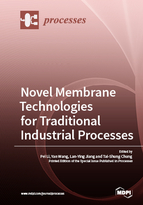Novel Membrane Technologies for Traditional Industrial Processes
A special issue of Processes (ISSN 2227-9717). This special issue belongs to the section "Materials Processes".
Deadline for manuscript submissions: closed (31 December 2018) | Viewed by 55204
Special Issue Editors
Interests: membrane separation; hollow fiber membrane; electrospinning; polymer synthesis; polymer nanocomposite; room temperature ionic liquid
Special Issues, Collections and Topics in MDPI journals
Interests: the development of novel membrane materials and processes for water treatment; liquid separation and organic solvent nanofiltration
Interests: current and upcoming effort is concentrated on hollow fibers membrane formation; nano-scale mixed matrix membrane; polymer blending; and membrane surface modification with particular emphasis to their applications in gas purification; solvent dehydration and organic/organic separations in bioenergy, chemical, petrochemical, and metallurgical industries
Interests: membranes for water reuse; desalination; gas separation; biofuel separation; energy development and CO2 capture
Special Issues, Collections and Topics in MDPI journals
Special Issue Information
Dear Colleagues,
Membrane separation technology has achieved successes in many industrial processes, such as water-related areas, including water purification, wastewater treatment, seawater desalination, etc., separation and purification of pharmaceuticals, chemicals, gases, and so forth. Membrane technology has intrinsic advantages, such as a small footprint, it is environmentally benign, has low operation costs, and a high efficiency. However, the industrial applications of membrane technologies are still limited. For instance, wastewater treatment and seawater desalination are still considered the largest market for membrane applications. Some other opportunities such as organic-organic separation, nature gas sweetnening, olefin/parafin separation are challenged by the problems including the low selectivity, poor stability, and fouling of the membrane materials.
This Special Issue on “Novel Membrane Technologies for Traditional Industrial Processes” aims to introduce some novel and state-of-the-art membrane separation technologies, including, but not limited to, forward osmosis (FO), pervaporation membranes (PV), and organic solvent nanofiltration membranes (OSN) for industrial applications. Research articles, as well as reviews, are invited. We hope that this Special Issue will provide some insights into the future directions of membrane technologies.
Topics include, but are not limited to:
- Pervaporation membranes for desalination of brackish, seawater and brines;
- Membranes based gas separation processes;
- The appliations of FO membranes in reverse osmosis and nanofiltration;
- Anti-fouling properties of membranes for water treatment;
- The applications of organic nanofiltration membranes.
Prof. Dr. Pei Li
Prof. Dr. Yan Wang
Prof. Dr. Lan-ying Jiang
Prof. Dr. Tai-shung Chung
Guest Editors
Manuscript Submission Information
Manuscripts should be submitted online at www.mdpi.com by registering and logging in to this website. Once you are registered, click here to go to the submission form. Manuscripts can be submitted until the deadline. All submissions that pass pre-check are peer-reviewed. Accepted papers will be published continuously in the journal (as soon as accepted) and will be listed together on the special issue website. Research articles, review articles as well as short communications are invited. For planned papers, a title and short abstract (about 100 words) can be sent to the Editorial Office for announcement on this website.
Submitted manuscripts should not have been published previously, nor be under consideration for publication elsewhere (except conference proceedings papers). All manuscripts are thoroughly refereed through a single-blind peer-review process. A guide for authors and other relevant information for submission of manuscripts is available on the Instructions for Authors page. Processes is an international peer-reviewed open access monthly journal published by MDPI.
Please visit the Instructions for Authors page before submitting a manuscript. The Article Processing Charge (APC) for publication in this open access journal is 2400 CHF (Swiss Francs). Submitted papers should be well formatted and use good English. Authors may use MDPI's English editing service prior to publication or during author revisions.
Keywords
- Pervaporation membrane for water treatment
- Gas separation membranes
- Forward osmosis
- Organic solvent nanofiltration
- Membrane fabrication









